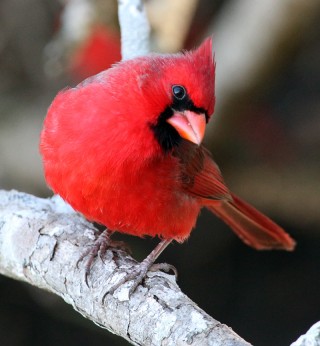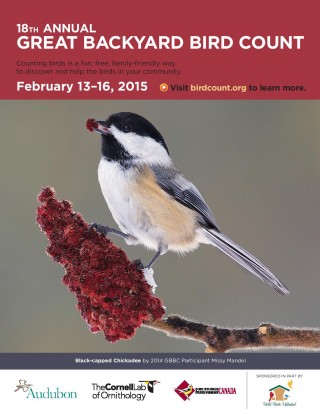
The Northern Cardinal was reported on more GBBC checklists than any other species. Since cardinals are a common North American Species, this wide-spread occurrence reflects the concentration of GBBC sites in the US and Canada. The situation is changing though. The GBBC is catching on rapidly all around the world. Robert Benson Photo.
02/07/2015 – Give Mother Nature a Valentine This Year
Do you love birds? Do you feed the birds and watch them? Why not go a step further and give them a Valentine!
Show how much you care about birds by counting them during the Great Backyard Bird Count. The Great Backyard Bird Count (GBBC) is an annual event held every February. This year the count days include Valentine’s Day weekend: Friday, February 13th through Monday, February 16th.
All you have to do is count the number of individual birds of each species you see during a 15-minute period (or longer) on one or more of the four days of the GBBC. This can be in your backyard, at a feeder, at a park or natural area, or almost any area where there are birds. You may then enter your numbers into the www.birdcount.org database.
This is a global count so your results will be compiled into a worldwide “snapshot” of how the birds are doing in 2015. Birders and scientists around the world will be able to see just how many species, and how many birds of those species, are where.
The GBBC has been going on since 1998 making the 2015 count the 18th in a row. This means we now will have 18 “snapshots” of the bird situation on Planet Earth. These data can be used to spot trends in population numbers, and in migration shifts. We will have a much better idea of the health of the bird species in our world.
Last year, 2014, was a record year for the GBBC. Birders from 135 countries participated. Over 4,300 species were documented and almost 150,000 checklists were submitted.
Can you guess what species was the most likely to be listed on a checklist? If you said, Northern Cardinal, you are right! Cardinals appeared on 61,045 checklists last year. Since the Northern Cardinal is a North American species, this reflects that participation in the Great Backyard Bird Count is still predominantly in the US and Canada.
But this is changing. India reported the highest number of species last year at 819. India is a very biologically diverse country with many native bird species, so it is not surprising that it produced a high species count. But they did so with only 3,358 checklists. By contrast, the United States submitted 18 times as many checklists for only half as many species!
On the state/province level, Texas was third in the number of species reported at 412. Our state was close behind California and the state of Puntarenas, Costa Rica. Texas is indeed rich in birds. I think we may have more species than California, but we’ll never prove it without the participation of many of our state’s birders!

This is the downloadable poster that invites everyone, of any skill level, to participate in the Great Backyard Bird Count. See link to the site in the body of this column. GBBC.org Image.
Last year produced an abundance of Snowy Owls in the top tier of the United States. Audubon Society scientists suggest that this year may be an “echo” year with many Snowy Owl sightings. Wouldn’t it be cool to see a Snowy Owl in Texas? It has happened.
Experts are also predicting an influx of finches: American Goldfinches, Pine Siskins, Purple Finches and the like. Are you getting any of these at your feeder this winter? It has been a lean winter for goldfinches at my feeder, but they must be somewhere. Perhaps the 2015 GBBC results will tell us where they are.
To make things even more fun, there is a GBBC Photo Contest. Just photograph birds during the four day period and submit your best shots in six categories: Bird in its Habitat, Composition, Bird Behavior, Groups of Birds, People and Birds, and Overall. And be sure to take a look at the Photo Gallery at www.birdcount.org for previous winners.
If you participated last year, I hope you’ll join us once again. If you are new to the GBBC, you will find it easy, fun, and free. Just go to the website and sign up. People of all ages and abilities are welcome.
So get ready to send Mother Nature a Valentine. Let her know that you too are concerned about the welfare of birds on this planet. Count the birds in your backyard at least once during the February 13-16, 2015 weekend and show your love!
If you would like to offer comments, please click through to the discussion page
